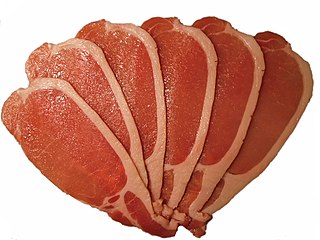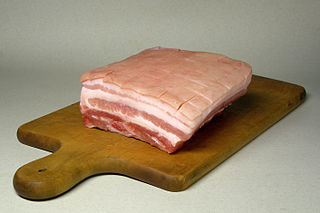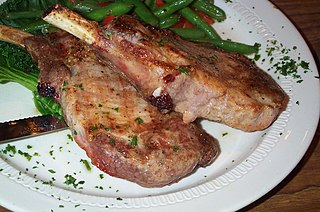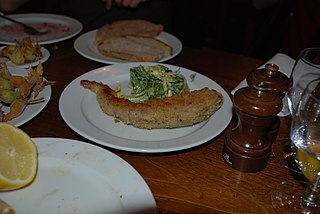 W
WBack bacon is a cut of bacon that includes the pork loin from the back of the pig. It may also include a portion of the pork belly in the same cut. It is much leaner than side bacon made only from the pork belly. Back bacon is derived from the same cut used for pork chops. It is the most common cut of bacon used in British and Irish cuisine, where both smoked and unsmoked varieties of bacon are found.
 W
WBoston butt, or pork butt, is the American name for a cut of pork that comes from the upper part of the shoulder from the front leg and may contain the blade bone. Boston butt is the most common cut used for pulled pork, a staple of barbecue in the southern United States.
 W
WThe cuts of pork are the different parts of the pig which are consumed as food by humans. The terminology and extent of each cut varies from country to country. There are between four and six primal cuts, which are the large parts in which the pig is first cut: the shoulder, loin, belly and leg. These are often sold wholesale, as are other parts of the pig with less meat, such as the head, feet and tail. Retail cuts are the specific cuts which are used to obtain different kinds of meat, such as tenderloin and ham. There at least 25 Iberian pork cuts, including jamón.
 W
WFatback is a cut of meat from a domestic pig. It consists of the layer of adipose tissue under the skin of the back, with or without the skin. Fatback is "hard fat" and is distinct from the visceral fat that occurs in the abdominal cavity which is called "soft fat" and is used to produce leaf lard.
 W
WGammon is the hind leg of pork after it has been cured by dry-salting or brining, which may or may not be smoked. Like bacon, it must be cooked before it can be eaten; in that sense gammon is comparable to fresh pork meat, and different from dry-cured ham like prosciutto. The term is mostly used in Britain, while other dialects of English largely make no distinction between gammon and ham.
 W
WGuanciale is an Italian cured meat product prepared from pork jowl or cheeks. Its name is derived from guancia, the Italian word for 'cheek'.
 W
WA ham hock or pork knuckle is the joint between the tibia/fibula and the metatarsals of the foot of a pig, where the foot was attached to the hog's leg. It is the portion of the leg that is neither part of the ham proper nor the ankle or foot (trotter), but rather the extreme shank end of the leg bone.
 W
WPancetta is a salumi made of pork belly meat that is salt cured. Pancetta in Italy is typically cooked to add depth to soups and pastas.
 W
WA pig's trotter, also known as a pettitoe, is the culinary term for the foot of a pig. The cuts are used in various dishes around the world, and experienced a resurgence in the late 2000s.
 W
WPork belly is a boneless cut of fatty meat from the belly of a pig. Pork belly is particularly popular in Hispanic, Chinese, Danish, Korean and Philippine cuisine.
 W
WA pork chop, like other meat chops, is a loin cut taken perpendicular to the spine of the pig and is usually a rib or part of a vertebra. Pork chops are unprocessed and leaner than other cuts. Chops are commonly served as an individual portion.
 W
WPork jowl is a cut of pork from a pig's cheek. Different food traditions have used it as a fresh cut or as a cured pork product. As a cured and smoked meat in America it is called jowl bacon or, especially in the Southern United States, hog jowl. In the US, hog jowl is a staple of soul food, and there is a longer culinary tradition outside the United States: the cured non-smoked Italian variant is called guanciale.
 W
WPork loin is a cut of meat from a pig, created from the tissue along the dorsal side of the rib cage.
 W
WPork ribs are a cut of pork popular in Western and Asian cuisines. The ribcage of a domestic pig, meat and bones together, is cut into usable pieces, prepared by smoking, grilling, or baking – usually with a sauce, often barbecue – and then served.
 W
WPork rind is the culinary term for the skin of a pig. It can be used in many different ways.
 W
WA pork steak, also called Boston butt or pork blade steak, is a steak cut from the shoulder of the pig.
 W
WPig tail, also referred to as pigtail and pork tail, are the tails from a pig used as a food ingredient in many cuisines. Pig tails can be smoked, fried, or roasted in barbecue sauce.
 W
WSpare ribs are a variety of ribs cut from the lower portion of a pig, specifically the belly and breastbone, behind the shoulder, and include 11 to 13 long bones. There is a covering of meat on top of the bones and also between them. Spare ribs (pork) are distinguished from short ribs, which are beef.
 W
WThe pork tenderloin, also called pork fillet or Gentleman's Cut, is a long thin cut of pork.